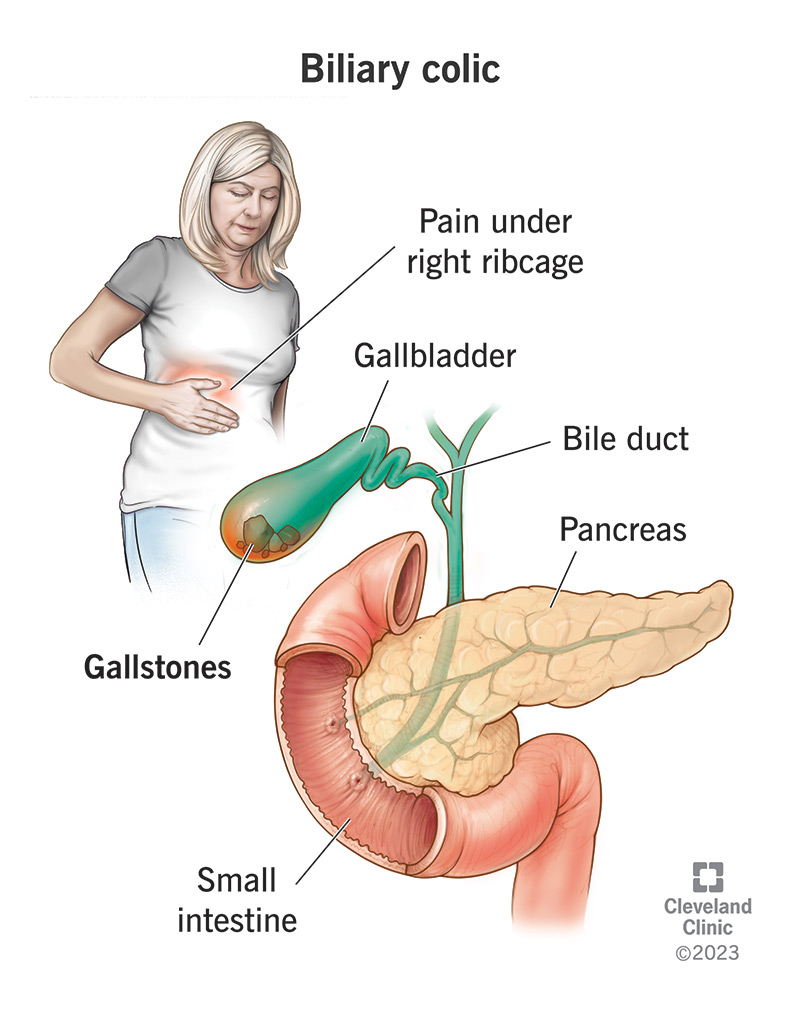Biliary colic is intermittent abdominal pain that comes from your biliary tract, usually from your gallbladder or bile ducts. You might feel it under your right ribcage or in your right shoulder. It’s often accompanied by nausea.
Advertisement
Cleveland Clinic is a non-profit academic medical center. Advertising on our site helps support our mission. We do not endorse non-Cleveland Clinic products or services. Policy

Biliary colic is a pattern of periodic abdominal pain that’s caused by an obstruction in your biliary tract, usually in your bile ducts or gallbladder. Gallstones are the most common cause, but there are others.
Advertisement
Cleveland Clinic is a non-profit academic medical center. Advertising on our site helps support our mission. We do not endorse non-Cleveland Clinic products or services. Policy
Colic is acute pain related to increased pressure in any of your hollow organs. It can also happen in your intestines, appendix, fallopian tubes or urinary tract, causing similar symptoms in different locations.
Biliary colic pain is:
Most people feel the pain in their upper abdomen, under their right ribcage. This is where your gallbladder and most of your biliary system are located. But it can also radiate to your right shoulder or back.
Biliary colic pain may be accompanied by:
Many people experience biliary colic shortly after eating, especially after a large or fatty meal. Fats in your small intestine trigger your gallbladder to contract so it releases the bile that helps digest fats.
Advertisement
An episode of biliary colic may last from 20 minutes up to a few hours. By definition, biliary colic is temporary. If the pain doesn’t go away after a few hours, it could be a more serious condition.
Cholecystitis is inflammation in your gallbladder. It feels similar to biliary colic. In fact, you may have biliary colic with cholecystitis if something is inflaming your gallbladder in an “on and off” sort of way.
But if something is inflaming your gallbladder persistently, the pain will remain and get worse. You might have a severe blockage or an infection in your gallbladder, which would need immediate treatment.
A severe blockage or infection may cause additional symptoms, including:
Cholangitis is inflammation in your bile ducts. It can be acute, due to an immediate condition, or chronic, due to a long-term condition. Acute cholangitis causes symptoms similar to an episode of biliary colic.
You may have biliary colic with cholangitis if something causes occasional inflammation that comes and goes. But if the pain continues, you have an ongoing problem, like a severe blockage or an infection.
Healthcare providers recognize acute cholangitis by a trio of symptoms known as Charcot’s triad:
A temporary increase in pressure within your biliary tract triggers the temporary symptoms of biliary colic. Pressure increases when your gallbladder contracts to release bile into your bile ducts.
Normally, you wouldn’t feel your gallbladder contracting. But if something is partially obstructing the flow of bile through your bile ducts, the contraction will cause pressure to build behind the obstruction.
The main cause of biliary colic is:
Gallstones are hardened pieces of bile sediment that can form in your gallbladder or bile ducts. They don’t always cause problems, but when problems occur in these organs, gallstones are often to blame.
If a gallstone gets stuck in the opening of your gallbladder or while passing through your bile ducts, it can either partially or completely obstruct the flow of bile. Biliary colic is a partial or temporary obstruction.
Biliary colic gets worse when bile backs up behind an obstruction, building pressure. It goes away when bile flow slows down after digestion, or when the gallstone budges and lets the bile pass through.
A gallstone may become dislodged and successfully pass through your bile ducts and out of your body. But if it continues to partially or occasionally obstruct bile flow, it will cause repeat episodes of biliary colic.
Advertisement
Other possible causes include:
Biliary stricture is the narrowing of your bile ducts due to scar tissue inside. A previous surgery or long-term inflammation in your bile ducts can cause it. Stricture restricts the flow of bile through your bile ducts.
If you have scarring in your bile ducts, it’s always there. But it might not be severe enough to cause symptoms, except when your gallbladder contracts. In this case, it could cause biliary colic.
Biliary dyskinesia means that one or some of the muscles that move bile through your biliary tract aren’t functioning well enough. This causes bile to back up in your system when your gallbladder contracts.
Most of the time, it’s your gallbladder that isn’t contracting effectively. Sometimes, the muscle that opens to let bile into your small intestine isn’t opening as it should (sphincter of Oddi dysfunction).
If you continue to have episodes of biliary colic after having your gallbladder removed, the problem is no longer your gallbladder. You may still have gallstones in your bile ducts even after gallbladder removal.
You may also have a condition unrelated to gallstones. For example, prior gallbladder surgery may have caused scarring that led to biliary stricture. Sometimes, people develop biliary dyskinesia after surgery.
Advertisement
Biliary pain indicates a problem that needs treatment. While biliary colic is temporary, it’s also likely to happen again, and the condition causing it is likely to worsen. It could easily become an emergency.
Healthcare providers treat biliary colic pain with common painkillers, like NSAIDs (nonsteroidal anti-inflammatory drugs). If you have some at home, you can take them before heading out to see a healthcare provider. But don’t wait to seek care.
Your treatment will depend on your condition. Some people need to have a procedure right away. Others can go home with medications, a strict meal plan and a follow-up appointment for a procedure.
Healthcare providers use imaging tests to check your biliary tract for the source of your pain. They’ll plan your treatment around what they find and how severe your symptoms are. Treatments may include:
Possible medications for biliary colic include:
If you’re prone to biliary colic, you can help prevent it by eating primarily low-fat foods. Fats in your small intestine trigger your gallbladder to contract, so limiting fats will reduce these contractions.
Advertisement
Gallbladder contractions cause pressure and pain in your biliary tract when it’s obstructed. Your gallbladder is a backup source of bile for your digestive system. If you don’t eat fats, you won’t need it.
If the source of your pain is in your bile ducts, your provider might be able to fix it with an endoscopic procedure. Endoscopy is an alternative to surgery that allows access to your insides without cutting.
A provider can access your bile ducts through an endoscopic procedure called ERCP (endoscopic retrograde cholangiopancreatography). They can remove blockages and place stents to open them.
If the source of your pain is in your gallbladder, the standard treatment is to remove your gallbladder. This is a simple procedure with an excellent prognosis (outlook). You can live well without a gallbladder.
Most people can have their gallbladder removed through minimally invasive laparoscopic surgery. A surgeon only needs to make two or three half-inch incisions to access and remove your gallbladder.
Always see a healthcare provider for severe and unexplained abdominal pain, especially if it doesn’t go away. If the episode has passed, but you think it was biliary colic, you should still make an appointment.
It’s important for a healthcare provider to determine the cause of your biliary colic and how urgent it is. They’ll recommend treatment based on your risk of worsening symptoms and serious complications.
For most people, one episode of biliary colic is enough to seek treatment. But you might be tempted to avoid it if you think it’s over for good, or if you feel anxious about having a medical procedure to fix it.
The causes of biliary colic rarely resolve by themselves. But the procedures that treat them are minor. Your treatment and recovery time will be brief, and you’ll have medications to make you comfortable.
Need care fast? Cleveland Clinic’s Express Care and Urgent Care locations treat everything from sprains to sinus infections — no appointment needed.

Last reviewed on 03/04/2024.
Learn more about the Health Library and our editorial process.